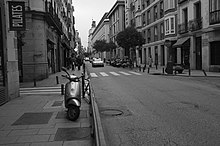 | |
| Type | street |
|---|---|
| Location | Madrid, Spain |
| South end | Gran Vía |
| North end | Plaza de Santa Bárbara |
The Calle de Hortaleza is a street in central Madrid, Spain. It is arguably the main thoroughfare passing through Chueca, the epicenter of the LGBT community in the city.
History and description

Entirely located in the administrative neighborhood of Justicia (Centro District), it starts at its junction with the Gran Vía (near the so-called "Red de San Luis"), and running northwards it ends at the Plaza de Santa Bárbara. a widening of the street, at whose end the Gate of Santa Bárbara was located in ancient times, the origin point of the roads to the villages of Chamartín and Hortaleza. In the 17th century the street was part of the slums beyond the boundaries of the enclosed city centre.
Some of the standout landmarks located along the street include the School of San Antón-Escolapios [es] (63), the convent of Santa María Magdalena de la Penitencia (88), the School of Santa Isabel (77), and the Fountain of San Antón.
References
- Citations
- Adams-Thies 2007, p. 17.
- Martínez & Dodge 2010, p. 226; 235.
- Gómez Iglesias 1966, p. 39.
- "Callejero Oficial del Ayuntamiento de Madrid" (PDF). Ayuntamiento de Madrid. 15 May 2017. p. 224.
- Muñoz de Pablo 2006, p. 480.
- Gómez Iglesias 1966, p. 41.
- Gómez Iglesias 1966, p. 47.
- Gómez Iglesias 1966, p. 50.
- ^ Gómez Iglesias 1966, p. 52.
- Bibliography
- Adams-Thies, Brian Luke (2007). "Perimeters, Performances and Perversity: The Creation and Success of a Gay Community in Madrid, Spain" (PDF). The University of Arizona. p. 17.
- Gómez Iglesias, Agustín (1966). "La Calle de Hortaleza". Villa de Madrid. V (20–21): 38–52. ISSN 0042-6164.
- Martínez, Omar; Dodge, Brian (2010), "El barrio de La Chueca of Madrid, Spain: An Emerging Epicenter of the Global LGBT Civil Rights Movement", Journal of Homosexuality, 57 (2): 226–248, doi:10.1080/00918360903488913, PMID 20390991, S2CID 26070087
- Muñoz de Pablo, María José (2006). "Las trazas de agua al norte de la Villa de Madrid" (PDF). Anales del Instituto de Estudios Madrileños (46): 467–520. ISSN 0584-6374.